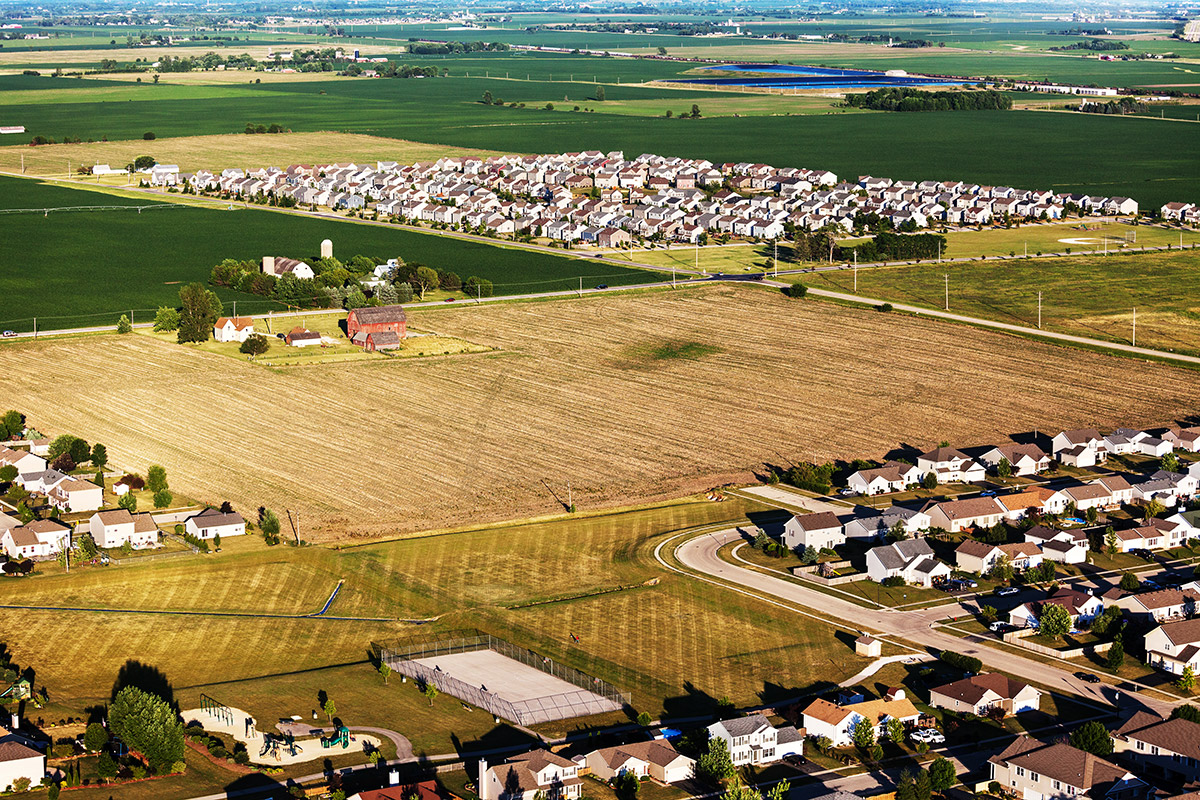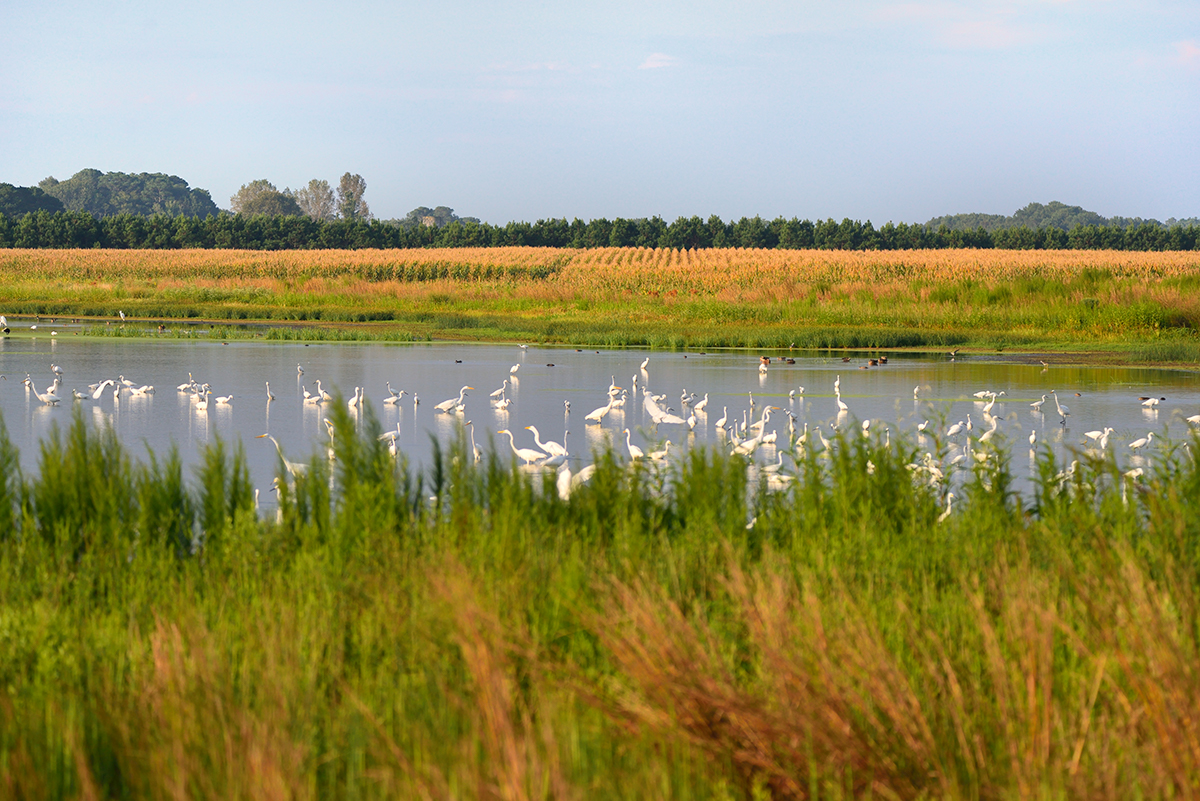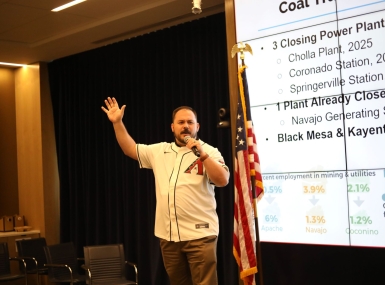Farm Bill 101: Overview of NACo priorities throughout the Farm Bill
Upcoming Events
Related News
Support Key County Priorities as Congress Begins Work on Next Farm Bill
Action Needed
This year, Congress began laying the foundation for the reauthorization of a new farm bill. Current legislation, the Agriculture Act of 2014 (P.L. 113-79), expires at the end of FY 2018. NACo has already testified before the U.S. House Agriculture Committee in preparatory hearings and continues to work with members of the committee on preserving county priorities in draft language.
Urge your members of Congress to support county priorities throughout the development of the next farm bill. Programs throughout the U.S. Department of Agriculture (USDA) help counties make critical investments in infrastructure, workforce and economic development, nutrition and conservation for some of our nation’s most underserved communities. Preserving these programs is vital to the strength and stability of our local and national economy.
Quick facts
- The Farm Bill contains programs that assist counties in rural development efforts, nutrition assistance programs, conservation initiatives, renewable energy deployment, support for new farmers and ranchers, and business development initiatives.
- The Rural Development title of the 2014 Farm Bill included $228 million in mandatory funding.
- Within the Rural Development title, the 2014 Farm Bill created the Strategic and Community Development program, championed by NACo, which helps incentivize regional collaboration in economic development.
- The Supplemental Nutrition Assistance Program (SNAP) received $90 million per year in the 2014 Farm Bill, a cut of $8.7 billion over ten years.
Background
The 2014 Farm Bill was a major piece of legislation that authorized a broad range of programs that are critical to counties. The legislation contains programs that assist counties in rural development efforts, nutrition assistance programs, conservation initiatives, renewable energy deployment, support for new farmers/ranchers and business development initiatives. All titles of the farm bill are important to the vitality of our nation.
In June of 2013, the U.S. Senate passed the Agriculture Reform, Food and Jobs Act of 2013 (S. 954) with broad bipartisan support by a vote of 66-27. The U.S. House of Representatives, however, failed to pass their long-term farm bill – The Federal Agriculture Reform and Risk Management Act of 2013 (H.R. 1947) – due to disagreements over funding levels for the Supplemental Nutritional Assistance Program (SNAP), formerly known as food stamps.
House leadership then separated the nutrition provision of the Farm Bill into a stand-alone title that made $40 billion in cuts to the SNAP program over the next ten years. The nutrition-only provision passed and was subsequently reattached to the House-passed “farm bill only” bill (H.R. 2642). In February, both chambers voted in favor of the final conference report, sending the bill to the President’s desk.
NACo championed the 2014 Farm Bill as it contained several critical county priorities, including FY 2014 Payment In Lieu of Taxes (PILT) program funding that provides counties with payments to offset forgone tax revenue due to the presence of tax-exempt federal land within their boundaries, reauthorizing vital programs within the rural development title, and protecting county authority over forest roads.
Why the Farm Bill Matters to Counties
This year, Congress began laying the foundation for the reauthorization of a new farm bill. Current legislation, the Agriculture Act of 2014 (P.L. 113-79), expires at the end of FY 2018. The legislation contains programs that assist counties in rural development efforts, nutrition assistance programs, conservation initiatives, renewable energy deployment, support for new farmers/ranchers, and business development initiatives.
All titles of the farm bill are important to the vitality of our nation. The farm bill should underscore the growing interdependence of rural and urban communities, and the common stake each has in ensuring that the remarkable assets of rural America are fully optimized.
General NACo Farm Bill Policy:
NACo supports a long-term reauthorization of the farm bill to help counties provide critical investments in our nation’s most underserved communities. NACo also supports full funding for all farm bill titles, which help strengthen our nation’s rural infrastructure including broadband and water and wastewater systems, protect our nation’s food supply, increase access to healthy food for low-income populations through the Supplemental Nutritional Assistance Program (SNAP), and promote environmental stewardship and conservation.
The farm bill helps counties make critical investments in infrastructure, workforce and economic development, and nutrition and conservation for some of our nation’s most underserved communities. Preserving these programs is key to the strength and stability of our local and national economy. NACo has already testified before the U.S. House Agriculture Committee in preparatory hearings and continues to work with members of the committee on preserving county priorities in draft language.

Title I: Commodity Programs
(Sugar, Dairy, Crop Payments and Disaster Assistance)
This title provides farm payments when crop prices or revenues decline for major commodity crops, and includes programs to help manage production losses due to natural disasters. Other supports included in this title include minimum price guarantees and barriers for sugar imports.
Programs of Interest
Livestock Forage Disaster Program
Compensates eligible livestock producers who have suffered grazing losses for covered livestock on land that is native or improved pastureland with permanent vegetative cover or is planted specifically for grazing. The grazing losses must be due to a qualifying drought condition during the normal grazing period for the county. It also compensates eligible producers who have suffered grazing losses on federally-managed land if the producer is prohibited from grazing on that land due to a qualifying fire.
Livestock Indemnity Program (LIP)
Provides benefits to livestock producers for livestock deaths in excess of normal mortality caused by adverse weather or by attacks by animals reintroduced into the wild by the Federal Government. LIP payments are equal to 75 percent of the average fair market value of the livestock.
Supporting NACo Policy
Drought Assistance
NACo urges Congress and the administration to pass disaster assistance aimed at farmers during times of drought and abnormal precipitation.

Title II: Conservation
The Conservation title encourages environmental stewardship and improved management practices through various conservation programs.
Programs of Interest
Environmental Quality Incentives Program (EQIP)
Provides financial and technical assistance to agricultural producers to help plan and implement conservation practices that address natural resource concerns and for opportunities to improve soil, water, plant, animal, air and related resources on agricultural land and non-industrial private forestland. It also assists producers to meet regulations. Contracts can be up to ten years in length. This program is administered by the USDA’s Natural Resource Conservation Service.
Conservation Reserve Program (CRP)
Provides annual rental payments to producers to replace crops on highly erodible and environmentally sensitive land with long-term resource-conserving plantings. The long-term goal of the program is to re-establish valuable land cover to help improve water quality, prevent soil erosion and reduce loss of wildlife habitat.
Agricultural Conservation Easement Program (ACEP)
Protects the long-term viability of the nation’s food supply by preventing conversion of productive working lands to non-agricultural uses through Agricultural Land Easements. The program also helps provide habitats for fish and wildlife, improve water quality, reduce flooding, recharge groundwater, protect biological diversity, and provide opportunities for educational, scientific and limited recreational activities through Wetland Reserve Easements. This program is administered by the USDA’s Natural Resources Conservation Service (NCRS).
Conservation Stewardship Program (CSP)
Provides financial and technical assistance to agricultural producers wishing to maintain and improve their existing conservation systems and adopt additional conservation activities to address priority resource concerns. CSP provides two types of payments through five-year contracts: annual payments for installing new conservation activities and maintaining existing practices, and supplemental payments for adopting a resource-conserving crop rotation.
Regional Conservation Partnership Program (RCPP)
Furthers conservation, restoration and sustainability efforts on regional or watershed scales, and encourages partners to cooperate with producers in meeting or avoiding regulatory requirements and implementing projects. This program is administered by the NCRS.
Small Watershed Rehabilitation Program
Assists local communities with rehabilitating watershed dams. This program is administered by the USDA’s Natural Resources Conservation Service (NRCS).
Supporting NACo Policy
Natural Resource Conservation Service
NACo supports USDA’s Natural Resource Conservation Service (NRCS) and the valuable technical assistance their field offices provide. NRCS plays a critical role for counties by addressing local conservation issues pertinent to county governments as well as Soil and Water Conservation Districts.
Wetlands and Watersheds
NACo supports Wetlands Conservation Plans, the Non-Point Source Grants Program and the Small Watershed Program for small agricultural watersheds.
NACo supports increased federal commitment to fund the repair and rehabilitation of America’s non-federal, publicly-owned dams and levees, including those constructed through agreements between counties and the National Resource Conservation Service, with priority funding given to structures presenting the highest risk of failure and which present the highest risk to homes, schools, businesses or important infrastructure in the event of failure. Federal funding should be made available through grants, loans and federal cost-share programs designed to ensure that unsafe or deficient dams and levees are brought into compliance with national minimum safety standards and to ensure that necessary maintenance and upgrades can be conducted to meet these standards on an ongoing basis. Moreover, NACo urges federal and state governments to consult with, and include, counties in the decision-making process when undertaking the rehabilitation of unsafe or deficient dams and levees located within the jurisdiction of the county.
Conservation Easements
NACo supports continuation of the enhanced federal tax deduction for donations of conservation and trail easements to facilitate their use by counties, special districts and other units of local government as a land planning, conservation and management tool.
NACo urges Congress to fund and expand backlogged farm conservation programs such as the Conservation and Wetlands Reserve, Buffer, and Farmland Protection Programs. Flexibility should be allowed in the Conservation Reserve Enhancement Program to permanently protect locally identified critical habitat areas. NRCS should be the sole federal agency with jurisdictional authority over agricultural wetlands areas in coordination with local officials.
NACo supports the option by local governments to implement Historical Building tax credits and conservation easement programs for historical preservation or to foster economic development, provided it is approved through local land use plans.
EQIP/CRP/CSP
NACo recognizes the need to protect our nation’s most environmentally sensitive lands and waters. Programs such as the Environmental Quality Incentive Program (EQIP), Conservation Reserve Program (CRP), Wetlands Reserve Program (WRP), Conservation Security Program (CSP) and others are important sources for technical assistance and are needed to help communities implement many important conservation measures.
Water Quality
The National Association of Counties (NACo) opposes the U.S. Environmental Protection Agency (EPA) efforts to implement localized numeric water quality-based effluent limitations or area pollution targets. NACo opposes any provisions of any watershed-wide strategy that penalize local governments by withdrawing current forms of financial assistance or imposing monitoring, management or similar requirements on localities without providing sufficient resources to achieve water quality objectives.
Loss of productive farmland
NACo is concerned about the loss of productive farmland to nonagricultural uses because of increasing development. NACo urges Congress and the USDA to support measures to retain, protect and improve agricultural land and conserve topsoil, consistent with local land use policies and controls. An important aspect of the conservation process is the maintenance of financial and technical assistance to establish practical methods to protect farmlands for American farm families and retain farmland to maintain stable production of farm commodities.
Pesticide Regulation
NACo supports using pesticides in accordance with the instructions on the label, and supports strong penalties for those who misuse pesticides in the Federal Insecticide, Fungicide, and Rodenticide Act (FIFRA). NACo opposes any legislation that expands the Environmental Protection Agency’s (EPA) jurisdiction in regard to pesticide use in (and around) county-owned and operated streets, gutters and ditches.

Title III: Trade
This title provides support for U.S. agricultural exports and international food assistance programs, both emergency and non-emergency. Other provisions in this title address program changes related to World Trade Organization (WTO) obligations.
Programs of Interest
Market Access Program (MAP)
Provides funding for export market development for U.S. agricultural commodities (generic and branded) by eligible trade organizations, as well as market development for organically-produced products.
Food for Peace
A program consisting of four titles that authorizes foreign food assistance.
Supporting NACo Policy
Subsidies and Trade Barriers
NACo believes that the competitive position of U.S. agriculture in world markets would be enhanced by the removal of certain barriers to trade in some foreign markets and by the termination of subsidies by foreign competitors.
Title IV: Nutrition
The Nutrition title provides nutrition assistance for low-income households and supports the distribution of food in schools.
Programs of Interest
Supplemental Nutritional Assistance Program (SNAP)
Offers nutrition assistance to millions of eligible, low-income individuals and families. The program is aimed at helping struggling families and has proven to be one of the most effective federal programs because benefits can reach families quickly during economic downturns as well as natural disasters.
The Emergency Food Assistance Program (TEFAP)
Helps supplement the diets of low-income Americans, including elderly people, by providing them with emergency food and nutrition assistance at no cost. This program is administered by the USDA Food and Nutrition Service.
Women, Infants and Children (WIC) Program
Aids low-income pregnant, postpartum and breastfeeding women, as well as infants and children up to age five who are at nutritional risk by providing food to supplement diets, information on healthy eating and referrals to health care.
Senior Farmers’ Market Nutrition Program
Awards grants to states, U.S. Territories, and federally recognized tribal governments to provide low-income seniors with coupons that can be exchanged for eligible foods (fruits, vegetables, honey, and fresh-cut herbs) at farmers’ markets, roadside stands, etc.
Food Insecurity Nutrition Incentive
Supports projects to increase the purchase of fruits and vegetables among low-income consumers participating in SNAP by providing incentives at the point of purchase.
Healthy Food Financing Initiative
Geared towards eliminating “food deserts,” the program supports projects that increase access to healthy, affordable food in communities that currently lack these options.
Food and Agriculture Service Learning Program
Aims to increase capacity for food, garden and nutrition education; complement the work of the federal farm-to-school grants and coordinate with the related National Institute of Food and Agriculture (NIFA) work.
Food Distribution Program on Indian Reservations
Provides USDA foods to low-income households, including the elderly, living on tribal reservations, and to Native American families residing in designated areas near reservations and in the State of Oklahoma.
Supporting NACo Policy
SNAP Program
Provides nutrition assistance funding to low income families and individuals to better support healthy and adequate eating habits. SNAP is critical to struggling families and has proven to be one of the most countercyclical federal programs because benefits can reach families quickly during economic downturns as well as natural disasters. The program serves diverse populations with a wide range of needs, and is administered by counties in a variety of states across the country. NACo supports moving a SNAP reauthorization in conjunction with a reauthorization of the Farm Bill.
NACo supports the current SNAP entitlement program and funding structure, including maintaining the 50 percent federal administrative match for states, since counties contribute to the administrative costs of the SNAP program in many county-administered states. SNAP should not be block granted, since such a policy change would place additional strain on both recipients and state and local governments.
WIC Program
NACo supports federal initiatives, including nutrition and food support programs, that help counties develop and expand early childhood and parent education programs, and supports continued expansion of WIC.
WIC and SNAP Programs
Adequate nutrition not only prevents serious health problems, but also helps children improve their ability to learn. The SNAP and the Feeding Program for WIC are valuable components of the continuum of services needed to ensure children’s physical and mental development. NACo therefore opposes further cuts to SNAP and supports continued expansion of WIC.
Healthy Food Access: NACo supports the promotion of healthy diets, including strengthening incentives and infrastructure to encourage more fruit/vegetable production. Incentives and infrastructure include better access to fresh foods, investment programs promoting healthy food, expansion of programs that help communities invest in retail markets and food-based businesses and increasing access to farmers markets. NACo also supports farm-to-school programs that bring fresh locally grown food into school lunch programs.

Title V: Credit
The Credit title offers direct government loans to farmers and ranchers, guarantees loans from commercial lenders, and sets eligibility rules and policies.
Programs of Interest
Beginner or Socially Disadvantaged Farmers and Ranchers
Provides grants to organizations for education, mentoring and technical assistance initiatives for beginning or socially disadvantaged farmers or ranchers.
Consolidated Farm and Rural Development Act (ConAct)
Three types of loans are available through the ConAct: farm ownership, farm operating and emergency. Ownership loans are for real estate purchases and require three years of farming experience. The operating loans are for purchasing livestock, feed, seed, equipment, supplies, land or water development, reorganization and certain other purposes. These borrowers must have a 75 percent stake in the farm. Emergency loans are for recovery from natural disasters and quarantines.
Conservation Loan and Loan Guarantee Program
The U.S. Department of Agriculture’s Farm Service Agency (FSA) makes and guarantees loans to promote conservation practices on farms and ranches that help protect natural resources throughout the United States. The goal is to provide access to credit for farmers who need and want to implement conservation measures on their land but do not have the “up front” funds available to implement these practices.
Supporting NACo Policy
Beginning Farmers
To keep the integrity of the family farm in place and in turn the fiscal solvency of many counties dependent upon agriculture, NACo supports the beginning farmer loan program. NACo also supports incentives, such as low-interest loans and tax credits, to be provided to young people entering farming and agribusiness in rural areas.
Conservation Loans and Assistance
NACo supports continuation of the enhanced federal tax deduction for donations of conservation and trail easements to facilitate their use by counties, special districts and other units of local government as a land planning, conservation and management tool.
NACo is concerned about the loss of productive farmland to nonagricultural uses because of increasing development. NACo urges Congress and the USDA to support measures to retain, protect and improve agricultural land and conserve topsoil, consistent with local land use policies and controls. An important aspect of the conservation process is the maintenance of financial and technical assistance to establish practical methods to protect farmlands for American farm families and retain farmland to maintain stable production of farm commodities.
Title VI: Rural Development
The Rural Development title supports rural business and community development and addresses a wide range of policy issues concerning rural America, including equity capital development in rural areas, regional economic planning and development, essential community facilities, water and wastewater infrastructure needs, value-added agricultural development and broadband telecommunications development.
Programs of Interest
Water and Waste Water Program
Helps counties fund and finance critical water infrastructure and provide rural communities access to clean, affordable water.
Distance Learning and Telemedicine Loan and Grant Program
Helps rural communities use the unique capabilities of telecommunications to connect to each other and to the world, overcoming the effects of remoteness and low population density. Eligible applicants include most entities that provide education or health care through telecommunications, including counties and federally-recognized tribes.
Community Facilities Direct Loan and Grant Program
Provides loans, grants and loan guarantees for essential community facilities in rural areas, with priority given to health care, education and public safety projects. This program is administered by the USDA’s Rural Development office.
Rural Cooperative Development Grant Program
Helps rural communities create and expand new markets and products through strategic investments. Funds grants that will improve the economic condition of rural areas by assisting individuals or entities in the startup, expansion or operational improvement of rural cooperatives and other business entities.
Value-Added Producer Grant Program (VAPG)
Helps agricultural producers enter into value-added activities related to the processing and/or marketing of new products. Provides grants to agricultural producers wishing to undertake projects that add value to their commodities and increase the producer’s income. The program is administered by the USDA’s Rural Development office.
Rural Microenterprise Assistance Program (RMAP)
Helps agricultural producers enter into value-added activities related to the processing and/or marketing of new products. Provides grants to third-party entities that assist rural entrepreneurs in establishing microenterprises in rural areas. This program is administered by the USDA’s Rural Development office.
Strategic Economic and Community Development Program
Allows the USDA to incentivize regional collaboration by prioritizing projects that are part of a multi-jurisdictional economic development plan.
Agriculture Innovation Center Demonstration Program
Funds innovation centers for work on providing technical and business development assistance to agricultural producers seeking to enter into ventures that add value to commodities or products they produce.
Rural Water and Waste Disposal Loan and Grant Programs
Provides funding for clean and reliable drinking water systems, sanitary sewage disposal, sanitary solid waste disposal and storm water drainage to households and businesses in eligible rural areas.
Emergency and Imminent Community Water Assistance Program
Helps communities prepare, or recover from, an emergency that threatens the availability of safe, reliable drinking water.
Water and Waste Facility Loans and Grants to Alleviate Health Risks
Provides low-income communities, which face significant health risks, access to safe, reliable drinking water and waste disposal facilities and services.
Water Systems Grants for Rural and Native Villages in Alaska and Hawaii
Helps remote Alaskan and Hawaiian villages provide safe, reliable drinking water and waste disposal systems for households and businesses.
Solid Waste Management Grants
Reduces or eliminates pollution of water resources by providing funding for organizations that provide technical assistance or training to improve the planning and management of solid waste sites.
Rural Water and Waste Water Circuit Rider Program
Provides technical assistance to rural water systems that are experiencing day-to-day operational, financial or managerial issues. Rural water system officials may request assistance from the Rural Utilities Service, or Rural Utilities Service staff may request assistance on behalf of the system.
Household Water Well Systems Program
Helps qualified nonprofits and tribes create a revolving loan fund to increase access to clean, reliable water for households in eligible rural areas.
Supporting NACo Policy
Water and Wastewater
Critical infrastructure, such as water and wastewater, remain a priority for many rural communities. The cost of building, maintaining and upgrading local water systems is a challenge for many small towns and rural counties. Beyond the public health interests, clean and reliable water is a necessity to spur economic growth. Studies have concluded that water and sewer projects can save or create jobs in rural communities by attracting and retaining businesses. Flexible cooperative/collaborative funding opportunities are encouraged.
NACo supports clarification of federal law to permit the proper maintenance of drainage systems according to the original intent and design of the law and to federal and state regulations established prior to 1985. Land designated as agricultural land prior to 1985 should not require restoration to conditions prior to agricultural use.
Broadband/Communications
Advanced telecommunications are critical to the economic vitality of rural America. According to the Federal Communications Commission (FCC), a lack of broadband infrastructure could limit the potential of rural communities to attract and retain businesses and jobs, especially businesses that are dependent on electronic commerce. Increased deployment of advanced technology has major implications for rural counties, including improved health care services through telemedicine, long-distance education, attraction of quality economic development and improved wages and employment. Advanced technology is a major key to closing the information gap between rural and urban areas. NACo supports congressional and administrative action that hastens the deployment of high-speed broadband technology in rural America.
Economic Development
NACo supports holistic approaches to rural development, such as the Rural Collaborative Investment Program (RCIP). By incorporating elected county and municipal officials, businesses and non-profits in a multi-county region, the program would allow multiple sectors a chance to chart the future of their community. Additionally, NACo urges Congress to provide increased funding for local capacity and technical assistance. NACo also supports improved coordination of the USDA’s economic development programs at the state, regional and local levels. Federal agencies should be required to recognize and follow county and regional development plans developed by local and elected officials.
VAPG/General
NACo supports investments in infrastructure, entrepreneurship programs and facilities that process, distribute and develop value-added products using locally-grown commodities purchased from local farmers to meet the demand for local, healthy food.
Rural Health Care
NACo recognizes the vital role that health care plays in rural America. The health care industry is an economic development engine and access to affordable health care is essential to spur new businesses. NACo supports strengthening the health care delivery system in rural America, including ambulatory services.
Title VII: Research, Extension, and Related Matters
This title offers numerous agricultural research and extension programs that help farmers and ranchers become more efficient, innovative and productive.
Programs of Interest
Foundation for Food and Agriculture Research
Operating as a non-profit corporation, leverages public and private resources to increase the scientific and technological research, innovation and partnerships critical to boosting America’s agricultural economy.
Agriculture and Food Research Initiative (AFRI)
Administered by the National Institute of Food and Agriculture (NIFA), AFRI provides grants for research, education and extension activities to combat childhood obesity, improve rural economies, increase food production, create new sources of energy, mitigate the impacts of climate variability, address water availability issues, ensure food safety and security and train the next generation of agricultural workforce.
Supporting NACo Policy
Healthy Food Access
NACo supports the promotion of healthy diets, including strengthening incentives and infrastructure to encourage more fruit and vegetable production. Incentives and infrastructure include better access to fresh foods, investment programs promoting healthy food, expansion of programs that help communities invest in retail markets and food-based businesses and increasing access to farmers markets. NACo also supports farm-to-school programs that bring fresh, locally grown food into school lunch programs.
Outreach Partnerships and Extensions
Across the country, counties partner with federal, state, local and tribal governments public and private sector interests; non-profit organizations; and colleges and universities to fund community outreach and educational initiatives. NACo reaffirms the importance of the work of the outreach programs and calls on federal, state, local and tribal governments; public and private sector interests; non-profit organizations; and colleges and universities to maintain their support.
NACo also calls upon the Extension Service to ensure that services adapt regularly to the needs of counties and create a formal process to ensure that counties play a partnership role in selecting extension staff and the topical focus of local agents. NACo supports the mission of the USDA and encourages it to focus on expanding the competitiveness of American agriculture and supporting rural businesses and industries that enhance rural development and quality of life in rural communities.
Title VIII: Forestry
The Forestry title supports forest management projects run by the U.S. Forest Service (USFS).
Programs of Interest
Federal Stewardship Contracting
Allows the USFS and Bureau of Land Management (BLM) to contract with states for management of federal forests and rangeland. Under the 2014 Farm Bill, stewardship contracts may last up to ten years.
Good Neighbor Authority
Allows the federal government to enter into an agreement with a governor to determine what acres to target for restoration projects (i.e. hazardous fuels reduction, insect and disease treatment, etc).
Supporting NACo Policy
Urban and Community Forestry Program
NACo supports full funding for the USFS’s Urban and Community Forestry program (U&CF) at a level that will help counties become more sustainable and viable, as counties can aid in meeting the challenge of increased leisure time by providing well-planned parks, open space, quality recreational opportunities and public education about the use of these facilities.
Federal Stewardship Contracting and Revenue Sharing
The USFS and BLM have permanent authority to enter into stewardship contracts for management of federal forests and rangelands. This authority does not include, however, traditional sharing with counties of revenues generated from these projects. NACo supports stewardship end results contracting projects as a tool to manage federal forests and rangelands, but only if they retain the historical receipts sharing with counties. Receipts sharing should be based on the total merchantable value of the products, rather than merely the net in excess of the contract amount.
NACo supports the sharing of federal leasing and rights-of-way revenues from renewable energy development (wind, solar and geothermal) and federal stewardship contracts on federal lands with county governments where those developments and contracts occur. Any revenue sharing program should not negatively impact the PILT program.

Title IX: Energy
The Energy title encourages development of farm and community renewable energy systems through grants, loan guarantees and other programs, etc. Provisions within the title cover production, processing and marketing of biofuels and biofuel feedstocks, as well as research, education and demonstration programs.
Programs of Interest
Biorefinery and Renewable Bio-based Product Manufacturing Assistance
Assists the development, construction and retrofitting of new and emerging technologies for advanced biofuels, renewable chemicals and bio-based products by providing loan guarantees up to $250 million.
Repowering Assistance Program
Provides funding for up to 50 percent of the total eligible project costs for biorefineries to install renewable biomass systems for heating and power at their facilities, or to produce new energy from renewable biomass.
Bioenergy Program for Advanced Biofuels
Supports and ensures expanding production of advanced biofuels by providing payments to eligible advanced biofuel producers.
Rural Energy for America Program (REAP)
The Rural Energy for America Program (REAP) provides financial assistance to agricultural producers and rural small businesses to purchase, install and construct renewable energy systems, make energy efficiency improvements to non-residential buildings and facilities, use renewable technologies that reduce energy consumption and participate in energy audits and renewable energy development assistance.
Biomass Crop Assistance Program (BCAP)
Provides financial assistance to owners and operators of agricultural and non-industrial private forest land who wish to establish, produce and deliver biomass feedstocks.
Supporting NACo Policy
Rural Energy Production
NACo supports comprehensive legislation to encourage and enable American agriculture to provide at least 25 percent of the total energy, including wind and solar, consumed in the United States by 2025 while continuing to produce abundant, safe and affordable food and fiber.
Renewable energy
NACo supports increased federal resources for researching and developing renewable energy technologies, including wind, solar, geothermal, biomass, electricity from landfill gas and other forms of waste-to-energy that will achieve the objective of clean and safe forms of energy.
NACo supports increased and multifaceted federal efforts to increase renewable energy sources and consumption, including consumption incentives to all levels of government to encourage purchase of renewable energy, industry tax incentives, such as R&D credits, encouragement to co-ops to replace wired electricity delivered to remote rural areas that are not cost-effective, and furthering public and private partnerships. NACo supports federal legislation and policies that enable funding mechanisms, including grant programs, for Community Renewable Energy Projects.
NACo is supportive of tax incentives to increase usage and reliance on renewable energy sources, but opposes mandates that will result in undue fiscal hardship to rural and agricultural users.
NACo supports the increased use and promotion of wind energy. Wind energy represents a clean and renewable source of electric power and it has great potential and should receive tax credits for production.
Biomass fuels
Biomass fuels (ethanol, bio-diesel) are paramount not only to the reduction of pollution in counties throughout the nation, but also serve as revenue generators for farmers that are struggling with low prices for their crops and increased costs of production. Their use and development should be encouraged and enhanced by Congress. NACo supports the definition of biomass from Titles I & III of the 2008 Farm Act.
NACo supports and encourages the further use, including government policies which foster the development, of woody biomass energy sources, like wood chips and wood pellets, because they are reliable, renewable and carbon neutral consistent with established and well-support science.

Title X: Horticulture
The Horticulture title supports specialty crops through various initiatives such as market promotion, plant pest and disease prevention and public research, as well as supporting organic agricultural production.
Programs of Interest
Section 10007 – Consolidation of Plant Pest, Disease and Disaster Prevention Programs
Administered by the USDA’s Animal and Plant Health Inspection Service (APHIS), this program funds projects that expand or enhance pest survey, identification, inspection, mitigation, risk analysis, and public education and outreach.
Supporting NACo Policy
APHIS/Pest Control
Wildlife can damage private and public property, including agricultural crops, livestock, forests, pastures and structures. NACo supports USDA Animal Plant and Health Inspection Service (APHIS) Wildlife Service (WS) programs and encourages Congress and the administration to provide necessary resources to strengthen these programs. NACo also opposes efforts to weaken WS programs, including efforts to decrease funding and change authorized abilities to cooperate with counties and other entities needing assistance.
Title XI: Crop Insurance
The Crop Insurance title enhances the permanently authorized federal crop insurance program. Crop insurance works like any other insurance: a farmer and provider enter into a contract that can be canceled or annually renewed. These contracts are made on a crop-by-crop, county-by-county basis. The farmers are insured against losses, with deductibles, that could be due to market price, adverse weather or other unavoidable perils. New plans include Stacked Income Protection (STAX) for cotton and Supplemental Coverage Option (SCO) for other crops.
Programs of Interest
Stacked Income Protection (STAX)
STAX is a revenue-based insurance policy that pays producers when there are revenue losses on the county level.
Supplemental Coverage Option (SCO)
Covers the losses created by a producer’s policy deductible, and can be triggered by county-level revenue losses or by an individual’s losses.
Supporting NACo Policy
Crop Insurance
NACo supports expansion of the crop insurance program to include additional crops, livestock and poultry. Additionally, NACo encourages Congress to provide a subsidy for hay production to assist agriculture communities, prevent soil erosion and improve water quality.
Title XII: Miscellaneous
This title covers other types of programs, such as livestock and poultry production and limited-resource and socially disadvantaged farmers.
Programs of Interest
Outreach and Assistance for Socially Disadvantaged Farmers and Ranchers
Provides education and outreach to minority and limited-resource farmers and ranchers. The 2014 Farm Bill extended eligibility to veterans.
Supporting NACo Policy
Socially Disadvantaged Farmers
NACo supports ‘agribility’ programs within USDA that help physically challenged farmers in their agricultural duties.
Beginning Farmers
To keep the integrity of the family farm in place and in turn the fiscal solvency of many counties dependent upon agriculture, NACo supports the beginning farmer loan program. NACo also supports incentives, such as low-interest loans and tax credits, to be provided to young people entering farming and agribusiness in rural areas.
Related News

White House OMB releases final revisions federal Uniform Guidance (2 CFR Part 200)
The White House OMB released final revisions to the federal Uniform Guidance that outline compliance and reporting requirements for federal financial assistance.

Coal counties search for a crystal ball to their futures
The transition from a coal-reliant community is not just an economic adjustment, it's a cultural transformation.

USDA secretary charts new course for small farms
Agriculture Secretary Tom Vilsack said Partnerships for Climate-Smart Commodities will set small-to-mid-sized farmers up for sustained growth and security.